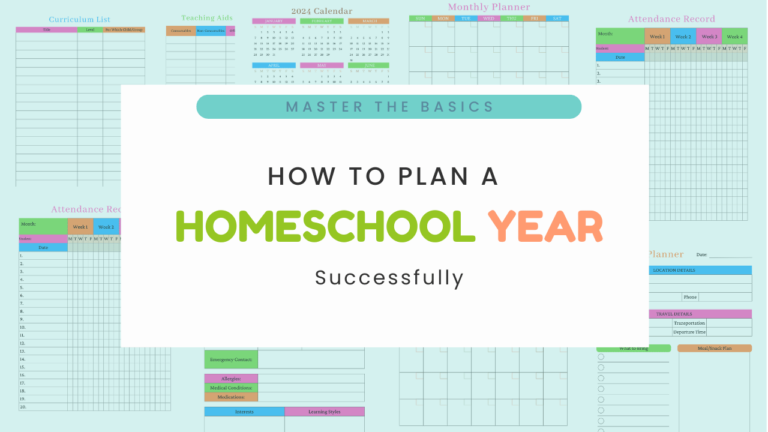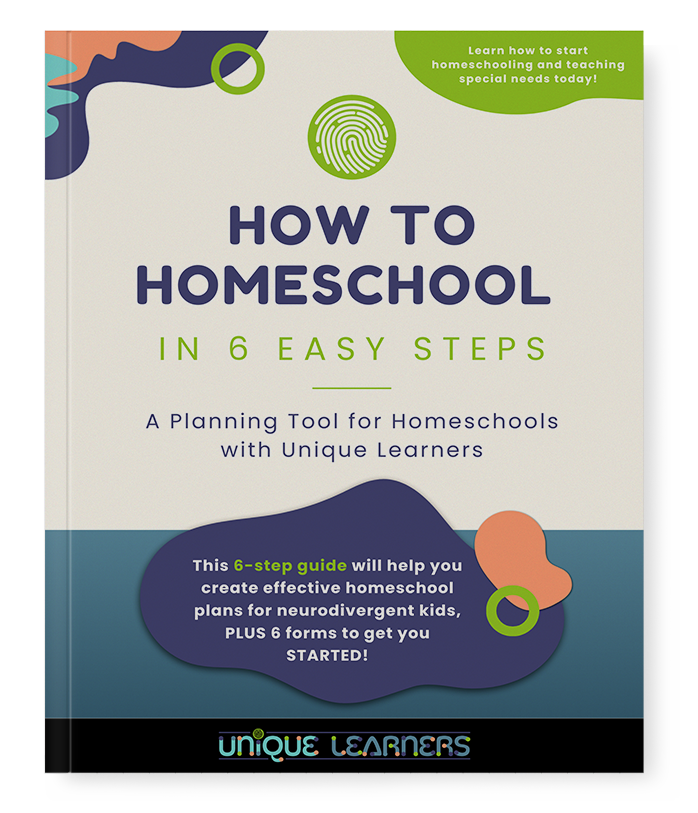Every parent who embarks on the journey of homeschooling their children carries a mix of excitement and trepidation. Excitement, because the opportunity to tailor education uniquely to your child promises a rewarding experience unlike any other. Trepidation, because navigating this path often feels like charting unknown waters, where the stakes are high, and the map is constantly evolving. Understanding how to plan a homeschool year successfully can transform this daunting task into a structured, achievable goal, leading to an enriching and satisfying educational experience for both parent and child.
As you stand at the threshold of designing your homeschool curriculum, it’s crucial to lay down a guiding framework that will ensure your journey is both effective and flexible. The secret lies in mastering the basics, from setting realistic goals and creating a routine to choosing the right resources and maintaining a balance between academics and extracurricular activities. This blog post will guide you through the essential steps, offering practical tips and insights that will pave the way for a fruitful homeschool year. With careful planning and a strategic approach, you’ll be empowered to create an educational environment where your child can thrive and develop a lifelong love for learning.
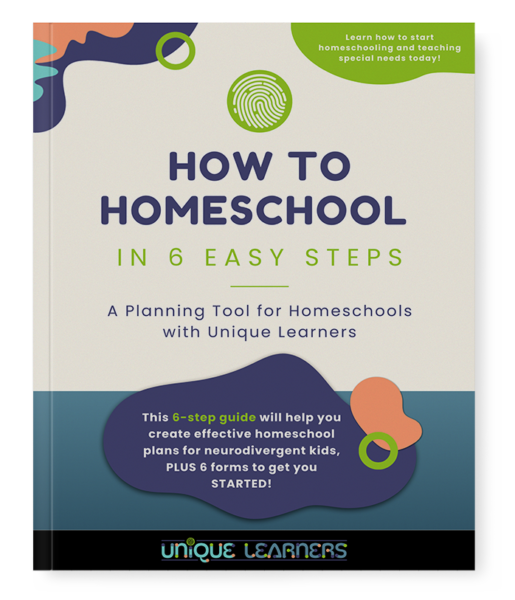
If you want a guide for how to plan a homeschool year, be sure to download our FREE e-book, “How to Homeschool in 6 Easy Steps” guide. It’s not just for families of kids with special needs. No matter what your situation is you can follow the basic steps to planning a homeschool year that works for you and your kiddos. You can also join our private “Homeschool Help for Special Needs” Facebook group for support. Plus, you will get our weekly email newsletter that gives you a heads up of the blog post for each week!
How to Plan a Homeschool Year Successfully by Setting Realistic Goals
Setting realistic goals is the foundation of learning how to plan a homeschool year successfully. It’s important to have a clear vision of what you want to achieve and how you plan to get there. Start by considering your child’s strengths, weaknesses, and interests. Take into account their age, grade level, and any specific educational requirements. Do NOT worry about state or common core standards.
When setting goals, it’s crucial to be realistic and attainable. Avoid overwhelming yourself or your child with unrealistic expectations. Break down larger goals into smaller, manageable ones that can be achieved over time. This will help maintain motivation and prevent burnout.
Another key aspect of goal-setting is involving your child in the process, especially for middle and high schoolers. Sit down together and discuss what they hope to achieve academically, physically, and socially during the homeschool year. Encourage them to set their own goals and provide guidance where needed.
Remember that homeschooling offers flexibility, so take advantage of this by setting personalized goals that align with your child’s unique needs and learning preferences. Celebrate milestones along the way and adjust goals as necessary throughout the year. It’s so much easier to make adjustments in a homeschool than in a large school system – even for kids with special learning needs.
Set Up Your Record Keeping System to learn How to Plan a Homeschool Year
When you have a solid record keeping system, you don’t have to worry about calls from a school district or state agency. Plus you have the tools you need to stay organized, keep on top of both school and home management, and monitor academic progress for your kiddos (no, not grading unless you want).
To help you learn how to plan a homeschool year, here’s our Unique Learners Homeschool Planner that gives you 72 pages of choices. No, you really do NOT need all 72 pages. The templates are for early childhood through high school, so not every page will apply to your situation. These are fun, brightly colored pages, as well as Sue’s own weekly planning pages. If you need help, you can always send us a message. We’re happy to help!
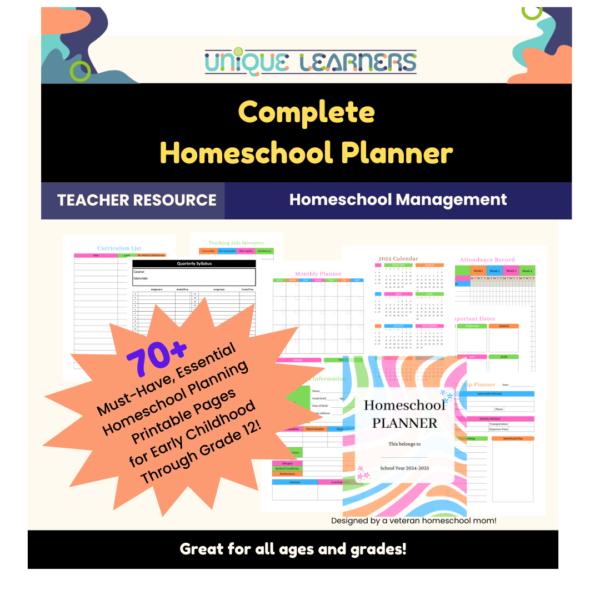
Creating a Flexible Routine that Works for Your Family
A flexible routine is essential when learning how to plan a homeschool year successfully. Unlike traditional schooling, homeschooling allows you to tailor the schedule according to your family’s needs and preferences.
Start by determining how many hours per day or week you plan to dedicate to homeschooling. Consider factors such as breaks, chores, and meal times. If your kids will be doing outside activities or classes that meet at a specific time, start by blocking those activities into your schedule. Be sure to allow travel time both before and after the activity.
Create a weekly timetable for big activities and major parts of the daily routine. Be sure to allow for flexibility within this structure, as unexpected events or opportunities are sure to arise occasionally. Then in the time allotted to work on paper work or textbook study, establish a routine of your expectations within the overall time without over-scheduling. When you have a super tight time-bound schedule, you and your kids are likely to become overwhelmed and frustrated. Allow your daily routine to just flow naturally within a bigger block of time.
Incorporate breaks throughout the day to prevent burnout and maintain focus. Consider your child’s attention span and energy levels when scheduling activities. As our kids got older, they preferred to concentrate and work hard to get their studying done in the morning, so the afternoons were available for projects, social activities, classes, and jobs. On the days where nothing was happening in the afternoon, they enjoyed the extra free time!
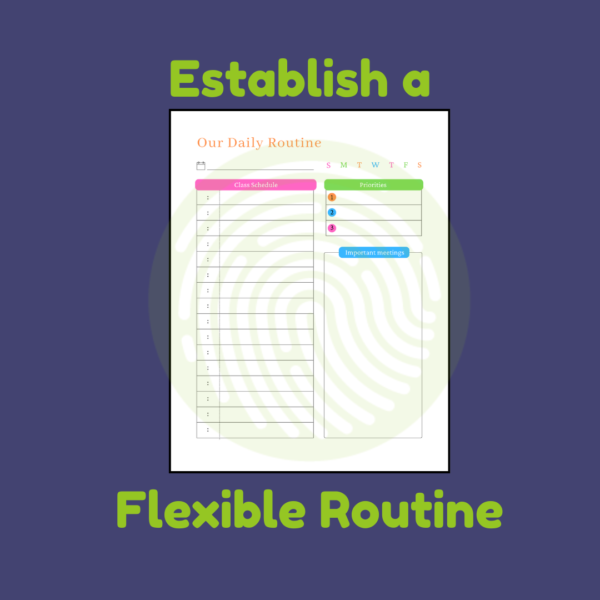
Remember that homeschooling doesn’t have to follow a traditional school schedule. You can choose to homeschool in the morning, afternoon, or even in the evening, depending on what works best for your family. For a few years, we had a homeschool/teacher store. Depending on when Mom’s shift was, we did school at home and brought some of the independent work to the store to complete there. When Dad had a work shift change, we did school in the late afternoon and evening. The change in routine helped our kids know that learning was not bound to a specific time of day helped them learn to be flexible.
Incorporating Different Learning Preferences into Your Plan
Every child has a unique learning preferences. Whenever possible, you can tailor your homeschooling activities to your child’s learning preferences rather than doing school as it would happen in a classroom setting. If your kids like to work on the floor, that’s ok. If they prefer documentary videos, that’s ok. If they learn best outdoors, plan for some math lessons outside.
When learning how to plan a homeschool year, you must identify your child’s learning preferences by observing how they best absorb and retain information. Visual, auditory, tactile, and kinesthetic learning “styles” are no longer considered important in helping a child learn, However, these are the modes of input for learning, so multisensory activities provide the most progress for accelerated learning regardless of a child’s unique preferences.
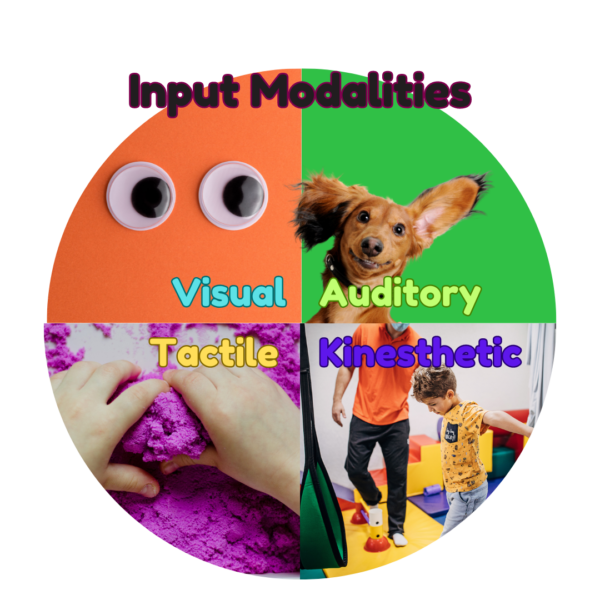
Multisensory learning activities are extremely important for kids with dyslexia, sensory needs, or other learning disabilities. By planning activities where a child sees a model, hears a rule or information, writes or touches textures with their fingers and hands, or does full body movement, the information is stored in multiple areas of the brain. Trying to have at least two of the input modalities used at the same time is best, but practicing spelling or math facts can be really fun if you mix up the fun to something different each day.
Online learning apps are very popular right now; however, younger kids and kids with special needs often require more direct interaction for understanding ideas, practicing skills, and focusing attention. Again, finding a good mix to keep the way school is done can make school interesting and engaging.
Fostering a Love for Learning through Engaging Activities and Projects
One of the greatest advantages of homeschooling is the ability to create engaging learning experiences that ignite a love for learning in your child.

Incorporate hands-on activities, experiments, and projects into your curriculum. This could involve field trips, science experiments, art projects, or even creating a garden. Tailor these activities to your child’s interests and incorporate their input whenever possible.
Encourage independent research and exploration. Provide resources such as books, documentaries, or online platforms that allow your child to delve deeper into subjects they find fascinating.
Make learning fun by incorporating games, puzzles, or educational apps into your homeschool routine. This not only keeps things interesting but also reinforces concepts in an enjoyable way.
Balancing Academics and Extracurricular Activities Effectively is Crucial when Learning How to Plan a Homeschool Year
When learning how to plan a homeschool year, finding the right balance between academics and extracurricular activities is crucial for a well-rounded homeschool experience.
Start by prioritizing core academic subjects such as math, language arts, science, and social studies. Allocate dedicated time each day or week for these subjects to ensure they receive adequate attention. We kept reading, grammar, and math as 1:1 time with Mom. Writing was done together and adapted up or down for each child. Bible, social studies, science, and a read aloud literature book were always done as a family. That way, I didn’t go crazy trying to get in multiple lessons at multiple grades. Grouping is ok!

Incorporate extracurricular activities that align with your child’s interests and passions. This could include sports, music lessons, art classes, or community service projects. These activities not only provide a break from academics but also foster personal growth and development. Our girls were into dance, which provided music and physical education. We loved 4-H because of the science focus and the co-ed learning with other families.
Be mindful of not overloading your child’s schedule with too many extracurricular activities! Find a balance that allows them to pursue their interests while still having enough time for academics and free play. Remember that the younger a child is, the more free play is an important part of learning. Even middle schoolers need way more free play than typically provided at a brick-and-mortar school.
A balance is very important to preserve time for academics in homeschooling. We had a few years where the structured social activities were nearly every afternoon and started to eek into the mornings. We were having a hard time getting in daily practice in reading, writing, and math. Fortunately, we homeschooled year-round, taking December and August off. We could always “catch up” because so much more learning happens in a homeschool setting than in an institutional school.
Conclusion: Embracing the Journey of Homeschooling with Confidence and Purpose
Homeschooling is an incredible opportunity to provide a personalized education for your child. By setting realistic goals, creating a flexible routine, incorporating different learning activities, and balancing academics and extracurricular activities effectively, you can learn how to plan a homeschool year successfully and nurture a love for learning. Give yourself grace. Even new classroom teachers find their first year to be the most difficult. Talk to other homeschool moms. Be confident to do things the way they seem to make sense to you. Your homeschool won’t look like any other family’s homeschool, and that’s OK!
Remember that every homeschool journey is unique. Embrace the challenges and celebrate the victories along the way. With confidence and purpose, you can create an enriching educational experience that nurtures your child’s growth academically, emotionally, and socially.
Don’t forget about your FREE e-book guide!
Are you new to homeschooling, or just wanting a fresh start? Download our FREE “How to Homeschool in 6 Easy Steps” guide and get valuable insights from Sue’s 30+ years of experience as a special educator and homeschool mom of 4!
Want to know about new products and blogs?
Join our email newsletter to get notified before anyone else when there is a new blog article or product.
Also, join our Facebook group!
Join our new “Homeschool Help for Special Needs” Facebook group! It is a place for homeschool moms to ask questions about homeschooling a child with special learning needs, share teaching and curriculum ideas that have worked (and those that bombed), and be real about the unique challenges of homeschooling with special needs. If you want to join us, be sure to answer the member questions to help us keep this private group secure. Join us now!
